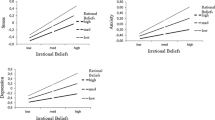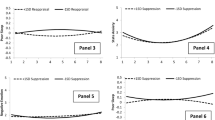Abstract
Individual differences in cognitive factors such as response expectancies and irrational beliefs (IBs) have been shown to contribute to variability in distress associated with stressful situations. However, their independent influence on distress when examined within the same study has not been established, nor has the potential of mediational relationships. The purpose of this study was to investigate the contribution of response expectancies and IBs (both general and exam-specific) to exam-related distress in a prospective study. Results revealed that both response expectancies and general IBs separately predicted exam-related distress (p’s<.05; N=105). Observed effects of general IBs were perfectly mediated by, and observed effects of exam-specific IBs were partially mediated by, response expectancies using the Baron and Kenny approach. These data support the view that cognitive factors contribute to psychological distress and are consistent with response expectancy and rational emotive behavior theories. The results suggest that interventions focused on response expectancies and IBs might be an effective means to reduce psychological distress associated with real life stressors such as exams. Future research is needed to determine whether this effect generalizes to other stressful situations.




Similar content being viewed by others
References
Alden L., Safran J., Weideman R., (1978). A comparison of cognitive and skills training strategies in the treatment of unassertive clientsBehavior Therapy 9:843–846
Baron R. M., Kenny D. A., (1986). The moderator-mediator variable distinction in social psychological research: Conceptual, strategic, and statistical considerationsJournal of Personality and Social Psychology 6:1173–1182
Beck A. T., (1976). Cognitive therapy and the emotional disorders International Universities Press, New York
Beck J. S., (1995). Cognitive therapy: Basics and beyond The Guilford Press, New York
Bernard M. E., (1998). Validations of the General Attitude and Beliefs ScaleJournal of Rational-Emotive and Cognitive-Behavior Therapy 16:183–196
Braffman W., Kirsch I., (1999). Imaginative suggestibility and hypnotizability: An empirical analysisJournal of Personality and Social Psychology 77:578–587
Braffman W., Kirsch I., (2001). Reaction time as a predictor of imaginative suggestibility and hypnotisabilityContemporary Hypnosis 18:107–119
David, A., Ghinea, C., Macavei, B., & Kallay, E. (2005). A search for “Hot” cognitions in a clinical and non-clinical context: Appraisal, attributions, core relational themes, irrational beliefs, and their relations to emotion. Journal of Cognitive and Behavioral Psychotherapies, 5(1), 1–42.
David, D., Schnur J., Belloiu A., (2002). Another search for the “hot” cognitions: Appraisal, irrational beliefs, attributions, and their relation to emotionJournal of Rational-Emotive and Cognitive-Behavior Therapy 15:93–131
DiGiuseppe, R., Leaf, R., Exner, T., & Robin, M. (1988). The development of a measure of irrational/rational thinking. Paper presented at the World Congress of Behavior Therapy, Edinburgh, Scotland
DiLorenzo T. A., Bovbjerg D. H., Montgomery G. H., Valdimarsdottir H., Jacobsen P. B., (1999). The application of a shortened version of the Profile of Mood States in a sample of breast cancer chemotherapy patientsBritish Journal of Health Psychology 4:315–325
Ellis A., (1962). Reason and emotion in psychotherapy Lyle Stuart, New York, NY
Ellis A., (1994). Reason and emotion in psychotherapy (Rev. ed.) Birch Lane, Secaucus, NJ
Goldfried M. R., Sobocinski D., (1975). Effect of irrational beliefs on emotional arousal. Journal of Consulting and Clinical Psychology 43:504-510
Harrell T.H., Chambless D. L., Calhoun J. F., (1981). Correlational relationships between self-statements and affective statesCognitive Therapy and Research 5:159–173
Jones M., (1968). Beyond the therapeutic community: Social learning and social psychiatry Yale University Press, New Haven, CT
Kirsch I., (1985). Response expectancy as a determinant of experience and behaviorAmerican Psychologist 40:1189–1202
Kirsch, I. (1990). Changing expectations: A key to effective psychotherapy. Pacific Grove, CA: Brooks/cole.
Kirsch I., (1999). Response expectancy: An introduction. In: Kirsch I., (eds), How expectancies shape experience. American Psychological Association, Washington, DC, pp. 3–14
Kirsch I., Montgomery G., Sapirstein G. ,(1995). Hypnosis as an adjunct to cognitive-behavioral psychotherapy: A meta-analysisJournal of Consulting and Clinical Psychology, 63:214–220
Lansky D., Wilson G. T., (1981). Alcohol, expectations, and sexual arousal in males. An information processing analysisJournal of Abnormal Psychology, 90:35–45
Lazarus, R. S. (1991). Emotion and adaptation. New York, NY: Oxford University Press.
Macavei, B. (2005). The role of irrational beliefs in the rational emotive behavior theory of depression. Journal of Cognitive and Behavioral Psychotherapies, 5(1), 73–81.
Malouff J. M., Schutte N. S., McClelland T. (1992). Examination of the relationship between irrational beliefs and state anxietyPersonality and Individual Differences 13:451–456
McDermut J. F., Haaga A. A. F., Bilek L.A., (1997). Cognitive bias and irrational beliefs in major depression and dysphoriaCognitive Therapy and Research 21:459–476
Montgomery G. H., Bovbjerg D. H., (2000). Pre-infusion expectations predict post-treatment nausea during repeated adjuvant chemotherapy infusions for breast cancerBritish Journal of Health Psychology 5:105–119
Montgomery G. H., Bovbjerg D. H., (2003). Expectations of chemotherapy-related nausea: Emotional and experiential predictorsAnnals of Behavioral Medicine 25:48–54
Montgomery G. H., Bovbjerg D. H., (2004). Pre-surgery distress and specific response expectancies predict post-surgery outcomes in surgery patients confronting breast cancerHealth Psychology 23:381–387
Montgomery G. H., Kirsch I., (1996). Mechanisms of placebo pain reduction: An empirical investigationPsychological Science 7:174–176
Montgomery G. H., Kirsch I., (1997). Classical conditioning and the placebo effectPain 72:103–113
Montgomery G. H., Weltz C. R., Seltz M. Bovbjerg D. H., (2002). Brief presurgery hypnosis reduces distress and pain in excisional breast biopsy patientsInternational Journal of Clinical and Experimental Hypnosis 50:17–32
Price D. D., Milling L. S., Kirsch I., Duff A., Montgomery G. H., Nicholls S. S., (1999). An analysis of factors that contribute to the magnitude of placebo analgesia in an experimental paradigmPain 84:110–113
Roscoe J. A., Hickok J. T., Morrow G. R., (2000). Patient expectations as predictor of chemotherapy-induced nauseaAnnals of Behavioral Medicine 22:121–126
Rotter J. B., (1954). Social learning and clinical psychology Prentice Hall, Englewood Cliffs, NJ
Schoenberger N. E., Kirsch I., Gearan P., Montgomery G., Pastyrnak S. L., (1997). Hypnotic enhancement of a cognitive-behavioral treatment for public speaking anxiety Behavior Therapy 28:127–140
Shacham S., (1983). A shortened version of the profile of mood statesJournal of Personality Assessment 47:305–306
Smith T. W., Brehm S. S., (1981). Cognitive correlates of the type A coronary-prone behaviour patternMotivation and Emotion 5:215–223
Solomon A., Arnow B. A., Gotlib I. H., Wind B., (2003). Individualized measurement of irrational beliefs in remmited depressivesJournal of Clinical Psychology 4:439–455
Tolman E. C., Honzik C. H., (1931). Introduction and removal of reward and maze performance in ratsUniversity of California Publication in Psychology 4:257–275
Walen S. R., DiGiuseppe R., Dryden W., (1992). A practitioner’s guide to rational-emotive therapy 2 Oxford University Press, New York, NY
Author information
Authors and Affiliations
Corresponding author
Additional information
Dr. Montgomery is Director of the Integrative Behavioral Medicine Program at the Mount Sinai School of Medicine. Dr. David is an associate professor at Babes-Bolyai University, in Romania. Dr. DiLorenzo is an assistant professor in the Psychology Department of Stern College. Dr. Schnur is a postdoctoral fellow in the Department of Oncological Sciences at Mount Sinai School of Medicine.
This work was supported by the National Cancer Institute (CA81137) and the American Cancer Society (PF-05-098-01-CPPB).
Appendix A
Appendix A
Exam-Related Beliefs Scale
Using the following scale, indicate in the space provided how true each of these statements is for you.
-
1. Strongly Agree
-
2. Somewhat Agree
-
3. Somewhat Disagree
-
4. Strongly Disagree
-
1. ............ I absolutely must get a good grade on this exam.
-
2. ............ I really want to get a good grade on this exam, but I do not absolutely have to.
-
3. ............ It will be awful if I don’t get a good grade on this exam.
-
4. ............ It will be really bad if I don’t get a good grade on this exam, but not awful.
-
5. ............ If I don’t get a good grade on this exam, I am not worthwhile.
-
6. ............ If I don’t get a good grade on this exam it is because I did not prepare myself well enough not because I am worthless.
-
7. ............ If I don’t get a good grade on this exam, I won’t be able to stand it.
-
8. ............ I could stand it if I don’t get a good grade on this exam.
-
Rights and permissions
About this article
Cite this article
Montgomery, G.H., David, D., DiLorenzo, T.A. et al. Response Expectancies and Irrational Beliefs Predict Exam-Related Distress. J Rat-Emo Cognitive-Behav Ther 25, 17–34 (2007). https://doi.org/10.1007/s10942-006-0029-y
Published:
Issue Date:
DOI: https://doi.org/10.1007/s10942-006-0029-y




